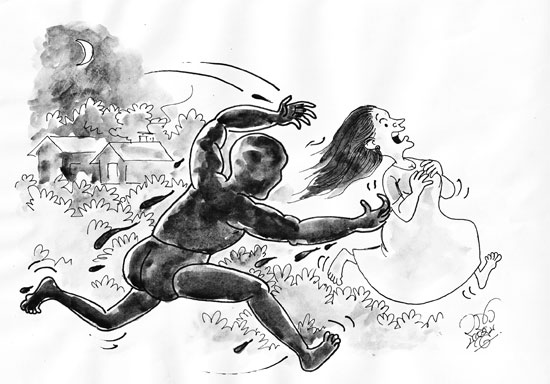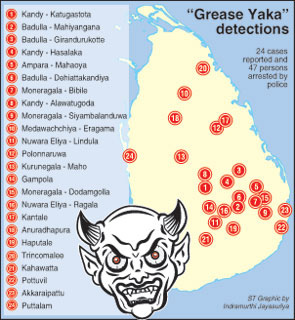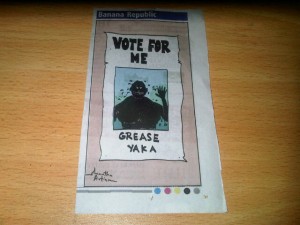
September 6, 2011

Cartoon in a Sri Lankan newspaper depicts a Grease Devil.
Today, September 6, 2011, with the grease devil fear continuing to grip the people of Jaffna, President Mahinda Rajapaksa has called for an immediate meeting with area politicians, army officers and the Jaffna District Secretary to discuss how best to put an end to this unhealthy trend.

“Minister Devananda who was asked by the President to arrange this meeting rushed to Jaffna for this purpose and to urgently address this crisis situation,” the sources said.
Tamil National Alliance (TNA) MP Suresh Premachandran said people did not even sleep properly fearing that some people disguising themselves as grease devils might come and harass them in the night.
Mr. Premachandran said his party, together with civil society activists, had organized a Sathyagraha next Saturday, September 10th, to protest at the failure by the authorities to bring normalcy to the area and said an appointment had been sought to meet the President to discuss this matter.
“In recent times, a number of youths have been assaulted by security personnel. This is serious,” he said.

During August this summer, Sri Lanka has been dealing with wave after wave of sightings of “Grease Devils,” which appear to be similar to the past encounters with Indian “Monkey-Men.” Then mid-month, the events took a turn for the worse.
Angry Sri Lankans killed a police officer on August 14, 2011, in the latest outbreak of violence sparked by a fear of nocturnal prowlers known popularly as “Grease Devils” that has gripped rural areas in the island nation over the past two weeks.
Another officer and five other people were hurt in two separate incidents in the northwestern Sri Lanka town Puttalam, after residents gave chase to a suspected “grease devil,” police and witnesses said.
Traditionally, a grease devil was a thief who wore only underwear and covered his body in grease to make himself hard to grab, but the modern iteration has a far more sinister reputation as prowling attacker of women. Reports in the media refer to them generally as “Grease devils” in English-“Kreese Pootham” in Tamil and “Thel Yaka” in Sinhala. This descriptive title is due to the fact that the assailants are said to be daubed in grease or some sticky,oily substance that makes their bodies slippery like eels thus making it difficult for people to catch hold of them. The grease devils are also said to be wearing crude masks or black paint or charcoal soot on their faces to avoid being identified
Five people have died in outbreaks of violence related to the grease devil panic so far, including the August 14th incident.
More than 30 incidents of violence and vigilantism have been reported in eight districts of the country, primarily in areas inhabited by minority Muslim or Tamil people as the government and opposition trade blame over the phenomenon.
“Some people had attacked a policeman on traffic duty in Puttalam town and he died after being admitted to the hospital,” police spokesman Prashantha Jayakody said.
Jayakody said that in a separate incident in Puttalam, people assaulted a police constable who went to the village. He declined to say what prompted the attacks.
Residents told Reuters that people had spotted an unidentified man and given chase, but policemen on duty fired in the air and later toward the crowd.
“At least five people were injured including a 13-year-old child,” said an area resident told Reuters by phone, speaking on condition of anonymity for fear of angering the authorities.
The government has said “grease devils” are merely criminals taking advantage of traditional beliefs in spirits and devils in Sri Lanka’s rural areas, and have vowed to punish those responsible for spreading panic about them.
On Saturday, in the nearby town of Kalpitiya, a government hospital refused treatment to a suspected “grease devil” who was brought by the navy after area residents attacked him.
Hospital officials were angry at damage caused to the building after residents and navy sailors who kept the man from being lynched got into a clash, local media reported.
About Loren Coleman
Loren Coleman is one of the world’s leading cryptozoologists, some say “the” leading living cryptozoologist. Certainly, he is acknowledged as the current living American researcher and writer who has most popularized cryptozoology in the late 20th and early 21st centuries.
Starting his fieldwork and investigations in 1960, after traveling and trekking extensively in pursuit of cryptozoological mysteries, Coleman began writing to share his experiences in 1969. An honorary member of Ivan T. Sanderson’s Society for the Investigation of the Unexplained in the 1970s, Coleman has been bestowed with similar honorary memberships of the North Idaho College Cryptozoology Club in 1983, and in subsequent years, that of the British Columbia Scientific Cryptozoology Club, CryptoSafari International, and other international organizations. He was also a Life Member and Benefactor of the International Society of Cryptozoology (now-defunct).
Loren Coleman’s daily blog, as a member of the Cryptomundo Team, served as an ongoing avenue of communication for the ever-growing body of cryptozoo news from 2005 through 2013. He returned as an infrequent contributor beginning Halloween week of 2015.
Coleman is the founder in 2003, and current director of the International Cryptozoology Museum in Portland, Maine.
Filed under Conspiracies, CryptoZoo News, Eyewitness Accounts, Forteana, Pop Culture, Weird Animal News